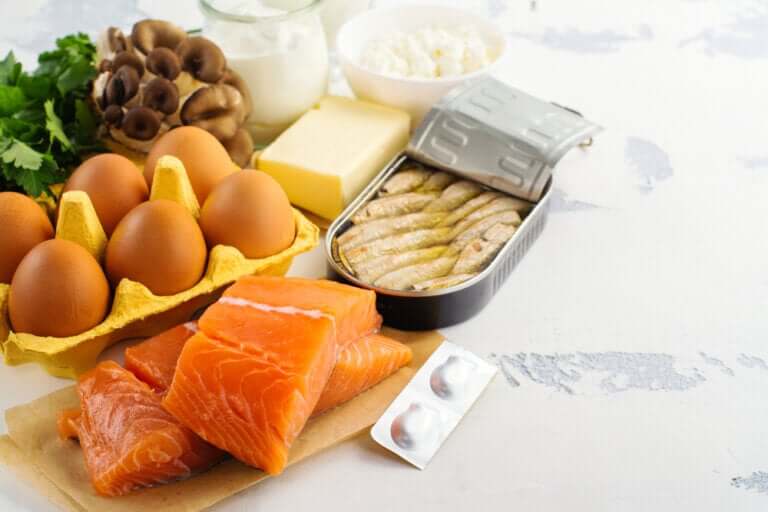How to Get Enough Vitamin D During Quarantine

The quantity of vitamin D in our body tends to be low among our population, regardless of a person’s age. And given our current circumstances, many parents are more concerned than ever. So, what can you do to make sure your family gets enough vitamin D during quarantine?
Whether we realize it or not, vitamin D plays a number of roles in our bodies. These functions have to do with our bones and our immune system, given that it acts as a hormone. In the following article, we’ll tell you more about the importance of vitamin D.
Vitamin D: What role does it play in our bodies?
One of the most well-known functions of this vitamin is that it facilitates the absorption of calcium in our bones. As a result, it helps to prevent fractures, osteopenia, and osteoporosis, which refer to the loss of bone mass.
However, it also plays a key role in regulating the functioning of the immune system. On the one hand, it prevents the body from reacting to its own cells and helps fight off infections and foreign substances. On the other hand, it boosts the tolerance of foods by reducing the risk of allergies and intolerances. The main reason is that it helps to maintain the integrity of our intestinal barrier.
Vitamin D also possesses an anti-inflammatory effect. This is especially true in individuals that suffer from obesity, inflammatory intestinal diseases, celiac disease, joint problems, arthritis, and lupus.
What’s more, adequate levels of vitamin D are also important when it comes to fertility and pregnancy. Vitamin D helps to prevent the appearance of preeclampsia, respiratory infections, premature birth, and low birth weight.
The metabolism of vitamin D
Vitamin D comes in two forms: D2 (ergocalciferol) and D3 (cholecalciferol). The difference between the two is that we find the first in plant sources and the second comes from animal sources. Their level of absorption is also different. In the case of cholecalciferol, given its greater affinity for our receptors, the level of absorption is high.

Both are transformed in the liver and kidney into active forms. After this, being liposoluble, they’re stored in our fat tissue.
How to get enough vitamin D during confinement?
Ideally, we should maintain serum concentrations of 250HD between 30 ad 50 ng/ml (75-125 nmol/l). Before we go into detail regarding the different strategies for guaranteeing the levels that official organizations have established, we should understand that these levels depend on numerous factors:
- Genetics.
- Age (levels decrease as a person gets older).
- Ethnicity and skin pigmentation.
- The amount of sun exposure a person gets, in regards to both time and surface area. This has to do with the amount of skin a person exposes and well as the amount of time he or she spends indoors.
- The use of sunscreen.
- Time of year.
- The latitude where a persona lives.
- The vitamin levels of the mother during pregnancy.
- Weight (obesity makes vitamin D’s function more difficult given that fatty tissue sequesters it).
- Intestinal illnesses, autoimmune disease, kidney failure, and liver failure.
- Outdoor physical activity.
- The use of certain pharmaceuticals (cholestyramine, anti-seizure medication, antiretroviral drugs for HIV, glucocorticoids, and antifungal medications).
Even contamination in the environment can decrease absorption levels.
Diet, the basic strategy for getting enough vitamin D during quarantine
While we only assimilate 10% of the vitamin D we need from food, a proper diet can be an ally. Mainly, we find vitamin D in the following food sources:
- Bluefish like longer ell, tuna, salmon, sardines, etc.
- Dairy products.
- Egg whites.
- Viscera.
- Cod liver oil.
- Shiitake mushrooms.
- Enriched vegetable drinks, like soy.
- Enriched cereals, such as oatmeal, with no added sugar.
- Avocado.
Sun exposure
Sun exposure contributes 90% to the amount of vitamin D our bodies absorb. This comes from the conversion of the 7-dehydrocholesterol present in the skin as it comes into contact with sunlight.
Therefore, it’s important to get at least 15 minutes of sun exposure each day. Of course, this is more difficult than usual, given that we’re spending more time inside our homes.
The solution? If you don’t have a yard, then open a window or go out on a balcony during the time of day when the sun is shining in. It’s important to open the window as glass acts as a shield. What’s more, if you go out to do any shopping, then stay out of the shade as much as possible and expose as much skin as you can. (For example, roll up your sleeves).

Vitamin D supplementation
And finally, in cases where vitamin D levels in the blood are below 30ng/ml, supplementation is necessary. To find out, you’ll need to have a blood draw, unless you already did just before confinement. Otherwise, it’s difficult to know how much you should take without putting yourself at risk. You should always consult your doctor or nutritionist before taking vitamin D supplements.
Keep in mind that these supplements come from the lanolin present in sheep’s wool. This is a D3 source, meaning it absorbs better, as we mentioned above. What’s more, it also comes in gel capsules that contain olive oil, which, as a fat, boost absorption.
Therefore, if that’s not the case, take the vitamin during breakfast along with a food that’s rich in fat. For example, avocado, oil, ham, egg, olives, cheese, or natural yogurt (not low-fat).
The minimum dose of vitamin D a person needs is as follows:
- 400 UI per day (10µg) up to 12 months of age.
- 600 UI per day (15µg) up to 70 years of age.
- 800 UI per day (20µg) in individuals over the age of 70.
You can also consume the following doses of vitamin D without putting your health at risk.
- Children between the ages of 1 and 10: 2000UI/day.
- Adolescents between the ages of 11-17: 4000UI/day.
- Adults over the age of 18: 10000UI.
Vitamin D during quarantine
In conclusion, remember that most people are in the same situation and there’s no need for major concern. Remember, our circumstances are temporary. Just the same, do your best to follow the recommendations provided in this article to maintain or slightly increase your levels of vitamin D during quarantine.
The quantity of vitamin D in our body tends to be low among our population, regardless of a person’s age. And given our current circumstances, many parents are more concerned than ever. So, what can you do to make sure your family gets enough vitamin D during quarantine?
Whether we realize it or not, vitamin D plays a number of roles in our bodies. These functions have to do with our bones and our immune system, given that it acts as a hormone. In the following article, we’ll tell you more about the importance of vitamin D.
Vitamin D: What role does it play in our bodies?
One of the most well-known functions of this vitamin is that it facilitates the absorption of calcium in our bones. As a result, it helps to prevent fractures, osteopenia, and osteoporosis, which refer to the loss of bone mass.
However, it also plays a key role in regulating the functioning of the immune system. On the one hand, it prevents the body from reacting to its own cells and helps fight off infections and foreign substances. On the other hand, it boosts the tolerance of foods by reducing the risk of allergies and intolerances. The main reason is that it helps to maintain the integrity of our intestinal barrier.
Vitamin D also possesses an anti-inflammatory effect. This is especially true in individuals that suffer from obesity, inflammatory intestinal diseases, celiac disease, joint problems, arthritis, and lupus.
What’s more, adequate levels of vitamin D are also important when it comes to fertility and pregnancy. Vitamin D helps to prevent the appearance of preeclampsia, respiratory infections, premature birth, and low birth weight.
The metabolism of vitamin D
Vitamin D comes in two forms: D2 (ergocalciferol) and D3 (cholecalciferol). The difference between the two is that we find the first in plant sources and the second comes from animal sources. Their level of absorption is also different. In the case of cholecalciferol, given its greater affinity for our receptors, the level of absorption is high.

Both are transformed in the liver and kidney into active forms. After this, being liposoluble, they’re stored in our fat tissue.
How to get enough vitamin D during confinement?
Ideally, we should maintain serum concentrations of 250HD between 30 ad 50 ng/ml (75-125 nmol/l). Before we go into detail regarding the different strategies for guaranteeing the levels that official organizations have established, we should understand that these levels depend on numerous factors:
- Genetics.
- Age (levels decrease as a person gets older).
- Ethnicity and skin pigmentation.
- The amount of sun exposure a person gets, in regards to both time and surface area. This has to do with the amount of skin a person exposes and well as the amount of time he or she spends indoors.
- The use of sunscreen.
- Time of year.
- The latitude where a persona lives.
- The vitamin levels of the mother during pregnancy.
- Weight (obesity makes vitamin D’s function more difficult given that fatty tissue sequesters it).
- Intestinal illnesses, autoimmune disease, kidney failure, and liver failure.
- Outdoor physical activity.
- The use of certain pharmaceuticals (cholestyramine, anti-seizure medication, antiretroviral drugs for HIV, glucocorticoids, and antifungal medications).
Even contamination in the environment can decrease absorption levels.
Diet, the basic strategy for getting enough vitamin D during quarantine
While we only assimilate 10% of the vitamin D we need from food, a proper diet can be an ally. Mainly, we find vitamin D in the following food sources:
- Bluefish like longer ell, tuna, salmon, sardines, etc.
- Dairy products.
- Egg whites.
- Viscera.
- Cod liver oil.
- Shiitake mushrooms.
- Enriched vegetable drinks, like soy.
- Enriched cereals, such as oatmeal, with no added sugar.
- Avocado.
Sun exposure
Sun exposure contributes 90% to the amount of vitamin D our bodies absorb. This comes from the conversion of the 7-dehydrocholesterol present in the skin as it comes into contact with sunlight.
Therefore, it’s important to get at least 15 minutes of sun exposure each day. Of course, this is more difficult than usual, given that we’re spending more time inside our homes.
The solution? If you don’t have a yard, then open a window or go out on a balcony during the time of day when the sun is shining in. It’s important to open the window as glass acts as a shield. What’s more, if you go out to do any shopping, then stay out of the shade as much as possible and expose as much skin as you can. (For example, roll up your sleeves).

Vitamin D supplementation
And finally, in cases where vitamin D levels in the blood are below 30ng/ml, supplementation is necessary. To find out, you’ll need to have a blood draw, unless you already did just before confinement. Otherwise, it’s difficult to know how much you should take without putting yourself at risk. You should always consult your doctor or nutritionist before taking vitamin D supplements.
Keep in mind that these supplements come from the lanolin present in sheep’s wool. This is a D3 source, meaning it absorbs better, as we mentioned above. What’s more, it also comes in gel capsules that contain olive oil, which, as a fat, boost absorption.
Therefore, if that’s not the case, take the vitamin during breakfast along with a food that’s rich in fat. For example, avocado, oil, ham, egg, olives, cheese, or natural yogurt (not low-fat).
The minimum dose of vitamin D a person needs is as follows:
- 400 UI per day (10µg) up to 12 months of age.
- 600 UI per day (15µg) up to 70 years of age.
- 800 UI per day (20µg) in individuals over the age of 70.
You can also consume the following doses of vitamin D without putting your health at risk.
- Children between the ages of 1 and 10: 2000UI/day.
- Adolescents between the ages of 11-17: 4000UI/day.
- Adults over the age of 18: 10000UI.
Vitamin D during quarantine
In conclusion, remember that most people are in the same situation and there’s no need for major concern. Remember, our circumstances are temporary. Just the same, do your best to follow the recommendations provided in this article to maintain or slightly increase your levels of vitamin D during quarantine.
All cited sources were thoroughly reviewed by our team to ensure their quality, reliability, currency, and validity. The bibliography of this article was considered reliable and of academic or scientific accuracy.
- Sassi F, Tamone C, D’Amelio P (2018) Vitamin D: Nutrient, Hormone, and Immunomodulator. Nutrients, 10 (11).
- Chang SW, Lee HC (2019) Vitamin D and health – The missing vitamin in humans. Pediatr Neonatol, 60(3): 237-44.
- O’Neill CM, Kazantzidis A, Ryan MJ, Barber N, Sempos CT, Durazo-Arvizu RA et al (2016) Seasonal Changes in Vitamin D-Effective UVB Availability in Europe and Associations with Population Serum 25-Hydroxyvitamin D. Nutrients, 8(9)
- Antonucci R, Locci C, Clemente MG, Chicconi E, Antonucci L. (2018) Vitamin D deficiency in childhood: old lessons and current challenges. J Pediatr Endocrinol Metab, 31(3): 247-60.
- Cabral M, Araújo J, Lopes C, Barros H, Guimarães JT, Severo M et al (2018) Relationship between dietary vitamin D and serum 25-hydroxyvitamin D levels in Portuguese adolescents. Public Health Nutr, 21(2): 325-32.
- Callegari ET, Garland SM, Gorelik A, Reavley NJ, Wark JD (2017) Predictors and correlates of serum 25-hydroxyvitamin D concentrations in young women: results from the Safe-D study. Br J Nutr, 118(4): 263-72.
- Varsavskya, M; Rozas Moreno,P;Becerra Fernándezc, A; Luque Fernández, I; Quesada Gómeze, JM; Ávila Rubio, V et al. (2017). Recomendaciones de vitamina D para la población general. Endocrinol Diabetes Nutr, 64(S1): 7-14.
- Marwaha RK, Dabas A (2019) Interventions for Prevention and Control of Epidemic of Vitamin D Deficiency. Indian J Pediatr, 86(6): 532-37.
- Rees JR, Mott LA, Barry EL, Baron JA, Bostick RM, Figueiredo JC et al (2016) Lifestyle and Other Factors Explain One-Half of the Variability in the Serum 25-Hydroxyvitamin D Response to Cholecalciferol Supplementation in Healthy Adults. J Nutr, 146(11): 2312-24.
- Pludowski P, Holick MF, Grant WB, Konstantynowicz J, Mascarenhas MR et al. (2018) Vitamin D supplementation guidelines. J Steroid Biochem Mol Biol, 175:125-135
This text is provided for informational purposes only and does not replace consultation with a professional. If in doubt, consult your specialist.








